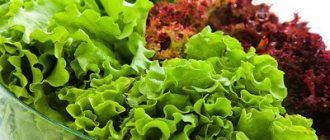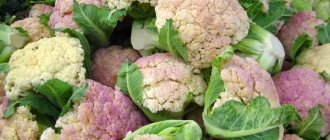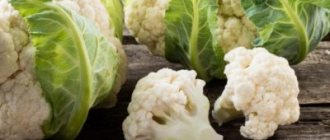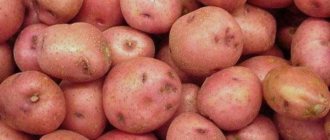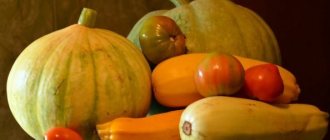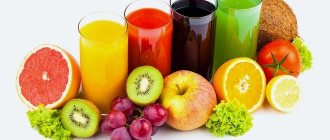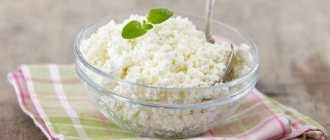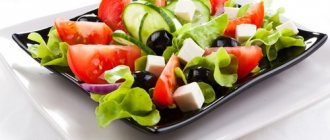Benefits and harms
When cooked, all the beneficial properties of cabbage are preserved. And the vegetable has a lot of them.
- With daily consumption of cabbage, the body will receive sufficient amounts of:
- potassium - it helps remove fluid from the body.
- vitamin PP, which stimulates metabolic processes;
- tartronic acid, which prevents the deposition of cholesterol on the walls of blood vessels;
- folic acid, necessary for hematopoiesis and the nervous system;
- which is necessary to strengthen the immune system;
- vitamin C.
- Cabbage dishes are useful for overweight people, but not only because of the low calorie content of the product (28 kcal per 100 g). The vegetable contains fiber, which helps cleanse the intestines, and choline, which normalizes metabolism.
- Vegetable juice stimulates digestion; it can be drunk separately or used as a base for fresh juices, mixed with the juice of carrots, beets, etc.
But the most important for diseases of the digestive system is S-methylmethionine, or vitamin U. This component is found in some vegetables, but in white cabbage - in record quantities. A lack of vitamin U in the body leads to disruption of food absorption processes and the formation of ulcerative erosions on the mucous membranes (the name of the vitamin is derived from the word “ulcus” - ulcer). Eating fresh greens and vegetables regenerates the mucous membrane.
However, while adhering to a healthy diet and including white cabbage, Brussels sprouts, cauliflower or broccoli in your diet for gastritis, you should also take into account the negative impact of cruciferous vegetables on the body. Nutritionists consider these types of vegetables harmful for people with diseases of the thyroid gland, liver and irritable bowel syndrome.
When eaten fresh, any type of cabbage will irritate the gastric mucosa, which causes pain and heartburn. The possibility of consuming juice or brine should be agreed with a gastroenterologist.
Benefit
Each of the existing types of cabbage is a container of components necessary for the body. The most valuable thing in it for gastritis is vitamin U or methyl methionine sulfonium. Its action is aimed at healing the mucous membranes of internal organs, which is why it is called an anti-ulcer factor. It neutralizes and removes histamine from the body, which is formed as a result of the inflammatory process and leads to swelling of the mucous membrane, and normalizes acidity. In addition to its beneficial effects on the digestive organs, vitamin U is necessary to strengthen blood vessels, improve fat metabolism, protect the liver from damage, and accelerate tissue regeneration. Each type of vegetable is saturated with its own components, which bring benefits not only to the stomach, but also to other systems of human life: nervous, immune, brain. Let's talk about the most popular ones separately.
White cabbage for gastritis
There are many varieties of cabbage, but the most common is white cabbage. It is impossible to imagine your diet without it, including our national dish - borscht. It is rich in vitamins PP, U, K, E, especially a lot of vitamin C; rare micro- and macroelements: sulfur, calcium, potassium, magnesium, iodine, iron, zinc, cobalt; amino acids: pectin, carotene, lysine. It is also valuable that any treatment does not significantly reduce these indicators, which is very important for gastritis, because fresh is not indicated at any stage of the disease. White cabbage for gastritis is consumed in this form:
- pickled - in times when there were no refrigerators, our ancestors, after harvesting the harvest, chose a day favorable for pickling, and chopped a large number of cabbage heads, flavoring them with grated carrots, salt, cumin (each housewife had her own recipe). All this was lowered into the cellar in buckets, transferred to oak barrels and pressed with a press. This was enough for the whole winter. Now there is no need to make such large-scale preparations; you can ferment a jar or two at any time. Sauerkraut restores the epithelium of the stomach, improves intestinal motility, normalizes its microflora, and improves immunity. At the same time, it increases the secretion of hydrochloric acid, which is why it is more suitable for hypocidal gastritis. Increased secretion of hydrochloric acid requires careful use in small portions;
- stewed - easier to digest, can serve as a side dish for meat dishes. It will protect the mucous membrane from harmful influences, promote the healing of damage, and speed up the relief of inflammation. For patients with reduced secretion function, it is a mandatory element of any dietary table;
- boiled - if the cabbage of the previous two cooking options causes bloating, flatulence, heartburn, you can boil it. In this form it is present in vegetable soups, borscht;
- Cabbage juice is an effective treatment for inflamed and damaged stomach walls. It acts as a sorbent, relieves nausea, removes toxins, and restores secretory function. It is considered an “ambulance” during disease outbreaks and is effective in the case of erosive gastritis. To prepare it, cabbage is ground in a meat grinder, then the juice is squeezed out, and 150-200 g are drunk before meals half an hour before.
[5], [6]
Chinese cabbage for gastritis
Chinese cabbage is more tender and softer than white cabbage and it also contains a lot of minerals, vitamins, alkaloids, organic and amino acids. Just lemon does not allow you to use it raw, because... can irritate the lining of the digestive organs. A serving of salad can cause heartburn, heaviness, bloating, and pain in the epigastric region. It can be stewed, added to soups and stews.
Cauliflower for gastritis
Cauliflower is easily digestible, it is low in calories, it contains an abundance of vitamins A, C, E, B2, calcium, copper, iron, fatty and organic acids, antioxidants, protein - all this allows it to be present in dietary tables. Cauliflower for gastritis is included in the diet a few days after the exacerbation is relieved. It can be baked, boiled in water or steamed. With all the love for it, patients with gout should not get too carried away in order to avoid exacerbation of the pathology. A sufficient norm is 2-3 times a week, 200-250 g.
[7], [8], [9]
Sea kale for gastritis
Sea kale or kelp is primarily famous for its rich content of iodine and chromium. In addition, it contains phosphorus, potassium, zinc, bromine, magnesium, sodium, B vitamins, fats, carbohydrates, and easily digestible proteins. It can increase the body’s protective properties, strengthen blood vessels, accelerate the removal of toxins, and normalize the functioning of the nervous system and metabolic processes. Chlorophyll in its composition has an anti-inflammatory effect, promotes the healing of various injuries and the rapid restoration of tissue cells of the internal walls of the digestive tract. Sea kale is also used for gastritis in remission, but only without the presence of vinegar, Korean carrots and various spices in it; such salads are also sold in retail chains. It must be remembered that seaweed has its own contraindications: kidney disease, excess iodine in the body, so the weekly dose should be within 250g.
Broccoli for gastritis
Broccoli looks like cauliflower, but is green in color, has a pleasant taste, and is more delicate in structure. Like all previous varieties, it requires heat treatment. Raw broccoli is not acceptable for gastritis, and the acute period precludes its use altogether. More suitable for people with reduced secretory function; increased secretory function requires moderate and careful use. Useful for its high content of magnesium, carotene, vitamin C, potassium, and antioxidants. With their help, it has a beneficial effect on the digestive organs, strengthens the immune system, fights inflammation of the mucous membrane, heals wounds and erosions. Studies have shown that eating 100g of broccoli daily prevents stomach cancer by reducing Helicobacter pylori gastric infection, which causes peptic ulcers and cancer.
[10]
Brussels sprouts for gastritis
It is considered the healthiest of all cabbage varieties. It is a champion in the presence of vitamin C (3 times higher than in white cabbage), it has a lot of folic acid, phosphorus, iron, sulfur, proteins and few calories. In addition to protecting against viruses and bacteria, it helps eliminate vitamin deficiency, strengthens blood vessels and the heart, lowers blood sugar levels, stimulates regenerative processes, it is famous for its hematopoietic, laxative effect, and in small quantities it is an astringent. Brussels sprouts are well accepted for non-exacerbated hypocidal gastritis. It has contraindications for high acidity, enterocolitis, and intestinal spasms.
[11]
Is it possible to eat stewed cabbage if you have gastritis?
When developing a treatment menu for gastritis, it is important to pay attention to the method of preparing dishes. Frying foods in a frying pan is prohibited, but any type of cabbage can be boiled or stewed.
Depending on the type of disease, you can prepare other dishes from cruciferous vegetables. It is necessary to exclude them from the diet only in case of acute gastritis.
With increased acidity
In chronic hyperacid gastritis, hydrochloric acid produced in large quantities irritates the walls of the stomach, which not only worsens the functional properties of the organ, but also disrupts the physiological processes of digestion. Patients experience pain between meals and heartburn.
With such symptoms, you should treat your diet carefully, adhering to a gentle diet. White cabbage or Brussels sprouts cause increased formation of gastric juice, so you should not include them in your diet.
For hyperacid gastritis, stewed cauliflower is useful. It can be steamed or boiled. It goes well with many approved meat products, other vegetables, and fish. In any form, it does not stimulate the production of acid in the stomach. It is easily digested and at the same time saturates the body with vitamins, potassium, carbohydrates, and microelements. Energy value - 30 kcal per 100 g.
At low
Hypoacid gastritis manifests itself differently. Due to insufficiently active digestion of food, the patient experiences nausea, dyspepsia, and belching is considered a common symptom. The mucous membrane also suffers and requires a gentle diet, but unlike the hyperacid form of the disease, culinary processing of foods may be different, because food should stimulate the production of gastric juice.
Vegetables are stewed, boiled, baked. You can combine it with all permitted products - meat, dairy, herbs and vegetables, eggs. It is also allowed to consume sauerkraut, juice and kvass from it.
For stomach and duodenal ulcers
It is possible to include any new dish in the diet of patients with ulcerative lesions of the gastrointestinal tract only without exacerbations. This rule also applies to such a dish as stewed cabbage.
During periods of stable remission, vegetable stews are gradually included in the diet. It is better to give preference to colored broccoli. They can be stewed, boiled, or used to make pureed soups. These varieties of vegetables do not irritate the injured mucous membrane and do not increase the secretion of gastric juice.
What is possible and what is not?
Allowed vegetables include carrots, potatoes, beets, cauliflower, etc. You can also eat a little green peas (they must be pre-processed and crushed to a mushy consistency), and in addition early zucchini with pumpkin and non-acidic tomatoes (no more than 100g in a day).
Potato
With the development of hyperacid gastritis, it is useful to eat potatoes raw - you should grind them through a grater and prepare juice from them.
You need to take potato juice in this way: at the initial stage, the dosage is 1 tablespoon (before meals (40 minutes)). You need to drink 2-3 of these spoons per day. Over time, the dose is increased and brought to 100 g per dose. To get rid of the pain that accompanies gastritis, you should lie down for about half an hour after taking the product.
The duration of the treatment course is 10 days. After this, you need to take a two-week break and then resume treatment.
Pumpkin
Pumpkin juice is considered the most useful and effective remedy used to relieve the symptoms of hyperacid gastritis.
The juice contains many useful substances - proteins, vitamins, as well as mineral salts with carbohydrates - this mixture helps improve the function of the gastrointestinal tract and increases the process of bile secretion. As a result, the level of gastric acidity decreases and digestive activity is normalized.
For gastritis, you need to drink juice for 10 days, once a day - 0.5 cup is enough.
Cabbage
Cabbage juice can be used to treat gastritis (both cauliflower and white cabbage can be used). This juice is believed to have many beneficial properties that can be used to relieve the symptoms of gastritis. Among them are the following:
- powerful anti-inflammatory effect, allowing you to quickly eliminate the symptoms of inflammation;
- effective sorbent;
- astringent effect;
- quick relief of pain and discomfort (removes nausea and heartburn);
- contains vitamin C;
- accelerates the healing process of ulcerative lesions;
- There are practically no side effects or contraindications;
- An excellent preventative against gastritis.
All these properties make it possible to use cabbage juice in the development of hyperacid gastritis. But it must be taken into account that it can enhance the process of gas separation, as a result of which, if constipation is also observed with gastritis, you should not drink this juice. To obtain the desired effect when using a medicinal product, you must follow these rules:
- You cannot salt such juice;
- You can drink juice whose temperature is equal to body temperature;
- The juice should be consumed before meals, 0.5 cups;
- You should drink no more than 1.5 glasses per day, i.e. A maximum of 3 doses is allowed.
[7], [8]
Beet
In case of hyperacid form of gastritis, beets can be consumed only during periods of remission - in small portions and only after heat treatment.
It retains its beneficial properties even after cooking - it has an anti-inflammatory effect, is a mild antidepressant, increases endurance, accelerates the healing process, and also acts as a pain reliever. That is why it is useful to eat boiled beets for gastritis. But at the same time, to get the maximum effect, it needs to be prepared correctly:
- first, it should be cooked exclusively in the peel;
- second, during the cooking process it is necessary to monitor the integrity of the peel (in order to preserve all the beneficial substances of the root vegetable);
- third, you need to cook the beets for no more than 15 minutes.
Boiled beets can become the main component for various salads (however, they cannot be seasoned with garlic and mayonnaise, which are prohibited for gastritis). To improve the taste of the dish, you can add low-fat sour cream or olive oil. But you shouldn’t salt the beets during the cooking process - their sweetness is quite capable of compensating for the lack of salt.
After heat treatment, onions can be added to salads and other snacks. It is not recommended to fry it in oil - it is better to pour boiling water over the chopped vegetable, then leave until it softens completely (this will replace the cooking process). Among the properties of boiled onions: preservation of nutrients, improvement of digestive function, increase in appetite.
[9], [10], [11], [12]
Cauliflower
The energy value of 100 g of cauliflower is 30 kcal. In addition, it contains many trace elements and carbohydrates, as well as sugars, potassium and vitamin C. In the case of gastritis with a high level of acidity, it should be consumed stewed (either in water or steamed), because in this form it does not provoke the production of hydrochloric acid. acids.
[13]
Tomatoes
The energy value of 100 g of tomatoes is 20 kcal. You should only eat ripe tomatoes, which contain large amounts of sugar. They are rich in substances such as chlorine, potassium and sodium, and in addition to vitamins A and C. For gastritis with high acidity, tomatoes are used in the form of sauces, as well as additives to pureed soups. Before eating, you need to remove the peel from them.
Peas
Peas contain a large amount of magnesium, as well as nucleic acids, which is why patients suffering from gastritis should consume soups with its addition. But it must be taken into account that such food is allowed to patients only at the stage of remission. In addition, it is forbidden to take dried peas - only fresh green peas should be used.
The recipe for making pea soup is similar to the rules for making any dietary soups used for gastritis. It is based on broth made from vegetables or low-fat meat. In this case, all the ingredients of such a soup should be mashed to a puree.
You need to add peas in the middle of the cooking process, and at the end of it, you also need to grind them to a puree using a mixer. At the end, you should add a little salt to the already prepared soup.
Sea kale
To treat gastritis, doctors recommend including foods that contain large amounts of zinc in your diet - this group also includes seaweed. But you need to take into account that it is allowed to use it only during the period of remission of the disease. At the acute stage, it is prohibited, because it sharply increases the level of acidity and also swells in the stomach, irritating the already damaged mucous membrane.
In some cases, you can use dried seaweed, ground into powder, but before taking the product in this form, you should consult a gastroenterologist.
Corn
Corn has a very balanced composition, which allows it to provide high digestibility of the beneficial nutrients it contains.
It also contains a lot of proteins with carbohydrates, which makes it possible to reduce the amount of meat consumed (especially fatty meat), which is very useful for gastritis, because this product is contraindicated for this disease. Thanks to corn, the functional activity of the gastrointestinal tract also improves.
The above properties make it possible to include corn in the nutritious diet necessary for hyperacid gastritis. It should be eaten in small portions in the form of soups, crushed to a puree. They have a beneficial effect on the gastric mucosa, providing a calming and enveloping effect. For gastritis, you can also eat steamed corn - in this form it retains all its beneficial properties.
[14], [15]
Zucchini, eggplant
With the hyperacid form of gastritis, it is allowed to eat steamed eggplants or zucchini. To improve the taste of this dish, you can season the vegetables with olive oil.
cucumbers
In the acute stage of gastritis, it is forbidden to eat fresh, unpeeled cucumbers. They can be consumed in small quantities only during the period of remission of the disease (they must be peeled).
[16]
Recipes
Dietary nutrition for patients with gastritis does not involve the use of fried ingredients, and the technology of culinary processing of vegetables must be strictly observed. Products must be fresh, well washed and cleared of hard peels and leaves.
Dietary version of the classic recipe
The recipe describes how to prepare white cabbage, but you can replace it with Brussels sprouts or broccoli if desired (they require less cooking time):
- Before stewing, finely chop 1 small head of cabbage.
- Sauté finely chopped 1 onion and 1 carrot with the addition of 1 tbsp. l. vegetable oil. When the vegetables become soft, add 2 chopped tomatoes to them. You can use tomato paste prepared without preservatives.
- Place all vegetables in a saucepan, stir, add 1 glass of hot water and cover with a lid.
- After boiling, reduce heat and simmer, stirring occasionally, for about 40 minutes.
- Before serving, add salt and herbs in small quantities.
With chicken breast
The dish becomes more satisfying with the addition of chicken. The dish is prepared from the same vegetable ingredients plus 0.5 kg of chicken breast fillet. The cooking technology is as follows:
- Shred the cabbage.
- Cut the meat into small pieces.
- Add meat to sautéed vegetables (onions and carrots), and after 5 minutes add tomatoes. Simmer until soft, avoiding the formation of a crispy crust.
- Place all ingredients in a saucepan, add water and simmer for about 40 minutes over low heat.
- Salt and herbs are added before serving.
Stewed cabbage in milk
You can prepare a dish from any type of cabbage, but cauliflower (even frozen) goes better with milk than others.
To prepare the dish you need to prepare:
- 0.5 kg cauliflower;
- 0.5 cups of low-fat milk;
- spices (salt, nutmeg).
Boil the cabbage until half cooked for 5-8 minutes, pour the broth into a separate bowl, and grind the vegetable in a blender. Pour 0.5 cups of broth and milk into the pan with the resulting puree and bring to a boil. Add spices. If desired, you can add butter to the dish (it must be natural).
White cabbage and how to cook it
Alas, white cabbage, which is familiar to us and loved by many since childhood, is not included in the products that are useful for pancreatitis. But this does not mean at all that such a valuable, popular and inexpensive vegetable should be abandoned altogether.
Yes, let’s not argue that the danger of white cabbage lies in the large amount of rather coarse fiber, the digestion of which requires the production of a sufficient amount of digestive enzymes, which is impossible with pancreatitis. Undigested fiber, in turn, provokes the appearance of dyspeptic symptoms, such as bloating and increased gas formation, and increases the level of acidity in the stomach, which leads to a worsening of the condition of patients with pancreatic pathologies.
In acute pancreatitis and during periods of exacerbation of the chronic course of the disease, the most inappropriate vegetable dishes on the table will be fresh or fermented cabbage. By the way, fresh cabbage is not recommended for use in case of any diseases of the pancreas associated with enzyme deficiency. As mentioned above, it is recommended to heat treat other types of cabbage, not to mention white cabbage, which is the most dangerous for the pancreas due to the coarse fiber it contains and essential oils that irritate the mucous membrane.
As for sauerkraut in any form, which seems more tender than raw cabbage, in case of pancreatitis you will also have to forget about it. To be more precise, this method of preparing cabbage is absolutely not suitable for an inflamed pancreas. The same fiber in combination with acid irritate the already inflamed mucous membrane of the organ, causing nausea and intestinal dysfunction, which is typical during exacerbations of pancreatitis.
What happens? A product that seems to be useful in all respects, stimulating secretory function and improving digestion, and suddenly turns out to be dangerous? Oddly enough, yes. But the whole problem is that sauerkraut, which is sour due to organic acids, by stimulating the secretion of gastric juice and pancreatic enzymes, only irritates the inflamed pancreatic mucosa, which is observed with pancreatitis.
And salt, without which cabbage cannot be fermented, does not play the best role. Sauerkraut is actually salty enough to cause swelling of the mucous membrane during pancreatitis (all thanks to the ability of salt to attract water) and increase pain.
Wait, but there are other ways to prepare vegetables. We will discard fried foods immediately, since they are prohibited for inflammation of the pancreatic mucosa. But boiled cabbage in limited quantities will not cause harm for pancreatitis. The only condition is the gradual introduction of boiled vegetables into the patient’s diet and only during the period of remission. First as part of liquid dishes, and then as a second course.
Cabbage should not be consumed as an independent dish for pancreatitis, unless the patient’s condition allows it and there are no negative reactions. It is better to add it to stews, omelets, cream soup, casseroles, but in limited quantities (from 50 to 70 g per day). In this case, it is imperative to monitor the patient’s condition.
Stewed cabbage is also not a prohibited dish for pancreatitis, because such processing of vegetables is quite acceptable. Thus, cabbage loses essential oils that irritate the mucous membranes, acquires a more delicate structure and is easier to digest.
But again, special caution is needed. Mandatory conditions remain the gradual introduction of stewed cabbage into the patient’s diet and its use only during periods of stable remission
It is especially worth focusing on cabbage juice, because for many gastrointestinal pathologies it is considered useful and even medicinal. But, alas, not for pancreatitis. Especially if the disease has an acute course, or is characterized by frequent relapses. It is better, if your stomach condition allows, to include a small amount of sauerkraut juice in your diet, which will not harm during remission of the disease, but will replenish the body with useful vitamins and microelements.
In the pharmaceutical industry, sauerkraut juice is used to produce enzyme preparations that are effective for pancreatitis.
Tips and tricks
For different types of gastritis, dietary tables are different, but the general principles of nutrition must be followed:
- dishes should not be hot or cold, the optimal temperature is +20...+50°C;
- meals should be fractional and regular: 5-6 times a day at the same time;
- with hyperacid gastritis, cabbage dishes should be excluded, with hypoacid gastritis, preference should be given to them;
- When preparing dishes, food should be crushed, and when consumed, chew thoroughly.
Patients with gastritis cannot help but adhere to the diet prescribed by the doctor, but before adding new dishes or products to the menu, they must coordinate their decision with a nutritionist or gastroenterologist, because diet is the basis of the treatment course.
If a gastroenterologist has diagnosed you with gastritis, he will definitely prescribe dietary nutrition. This diet includes the consumption of vegetables, including cauliflower. What is the benefit of this vegetable in the treatment of gastritis? What delicious dishes should you prepare during a therapeutic diet? Answers to such questions can be found in this article.
Cooking methods
Pickled
Sauerkraut will be useful for gastritis when the disease is in remission, because it promotes:
- improving motility and the entire intestinal microflora;
- eliminating constipation;
- increasing immunity;
- eliminating inflammation of the gastric mucosa.
You can eat sauerkraut in small quantities without exacerbation of gastritis with low acidity. It promotes the production of gastric juice.
The reason for refusing this dish is acute gastritis with high acidity, heartburn and discomfort in the abdomen.
Stewed
https://www.youtube.com/watch?v=cMiWu3cjFQw
We suggest you familiarize yourself with: Low-growing tomato for open ground
Stewed cabbage for gastritis will be a positive product on the menu. After all, during cooking, the vegetable retains many beneficial properties that are easily digested. This dish has several advantages:
- helps relieve inflammation of the mucous membrane;
- helps improve digestion;
- helps reduce pain.
It is better to eat stewed cabbage for gastritis with low acidity or during the period of attenuation of the disease.
Cabbage juice
This drink is widely used in traditional medicine for gastritis. It retains all the beneficial properties of a fresh vegetable, but at the same time it does not contain coarse fibers that cause irritation to the mucous membrane. Its advantages are that the juice:
- heals damaged areas;
- helps relieve heartburn and nausea during acute gastritis;
- removes toxins and waste from the intestines.
You should start using it with a small amount, because it can cause rumbling in the stomach and discomfort.
The drink should be abandoned if the illness is accompanied by high acidity, because cabbage promotes the production of gastric juice.
Cabbage is a very healthy product, so you shouldn’t limit yourself to its consumption. You just need to approach preparation wisely and follow all the advice. Also, before including this product on the menu, do not forget to consult your doctor so that you do not experience complications.
Cauliflower and its benefits for gastritis
Experts believe that a vegetable such as cauliflower adds variety to the dietary menu, compiled specifically for sick people suffering from gastritis. This is directly related to its chemical composition, which is distinguished by its richness of nutrients and beneficial substances:
- vitamins – C, B1, B2, B6, PP, A;
- microelements – sodium, potassium, calcium, magnesium, phosphorus, iron;
- sugars;
- starch;
- fiber;
- raw protein;
- fat
Among the many beneficial properties of this vegetable, gastroenterologists highlight the following:
- Accelerates the regeneration of damaged areas of the gastric mucosa.
- Restores metabolic processes in the patient's body.
- Increases immunity.
For gastritis, this type of cabbage is included in the diet menu because it is absorbed much better than other varieties of this plant. This benefit is due to its fine cellular structure, which results in less coarse fiber.
And with easy digestion of a properly prepared cabbage dish, the gastric mucosa, inflamed due to gastritis, is less irritated.
With atrophic gastritis
This type of disease is characterized by a significant decrease in functioning cells, as well as thinning of the gastrointestinal mucosa. During this period, gastric juice is poorly produced and the acidity of the organ decreases. For this reason, food entering the stomach is poorly processed. Sauerkraut, when fermented, is enriched with pectin substances, which act as anti-carcinogenic and anti-inflammatory substances. It significantly improves immunity and normalizes intestinal motility
It is important to avoid adding various spices and unfamiliar ingredients to the product.
How to properly cook cauliflower for gastritis
Cauliflower in dietary nutrition is not consumed raw, except for freshly squeezed juice. The cooking options for this vegetable for the diet menu for gastritis are as follows:
- boil (to do this, the prepared inflorescences are lowered into boiling water for literally a few minutes - no more than 5-7 minutes);
- steamed (for this preparation you will need a steamer; steaming cabbage inflorescences also does not take much time);
- stew (the inflorescences are dipped in boiling water, but the amount is less than when boiling, add carrots, onions and butter, cook for about twenty minutes);
- baked (as a separate dish or together with other vegetables).
What kind of cabbage can you eat for gastritis of the stomach with low and high acidity?
For gastritis, experts allow eating white cabbage, but only in moderation. It is recommended to eat cabbage pickled, stewed or boiled.
For gastritis, experts allow eating white cabbage, but only in moderation. It is recommended to eat cabbage in pickled, stewed or boiled form.
In its raw form, with gastritis, cabbage can cause unpleasant discomfort and even heartburn, which experts explain by the presence of a large amount of fiber in the vegetable, which can damage the irritated and inflamed gastric mucosa. But cabbage contains many useful substances that are necessary for problems with digestive structures. The vegetable contains vitamin U and nicotinic acid, which promote accelerated healing of damaged mucous membranes and restoration of the protective layer on their surface.
Nicotinic acid is able to neutralize cholesterol excesses, ridding the body of such unsafe atherosclerotic plaques, and also normalizes blood circulation and metabolic processes. If gastritis of any type has developed, it is recommended to eat cabbage in processed form, for example, pickled, boiled or stewed. During remission periods, cabbage helps for preventive purposes, but if the pathology worsens, it is better to avoid the vegetable for a while.
Several recipes for cooking cauliflower for a diet for gastritis
The recipe for the first course is “Cauliflower soup.” For this soup, in addition to the main ingredient, you will need the following vegetables - carrots, onions, bell peppers, tomatoes. The washed vegetables are poured with hot water and boiled for twenty minutes, after which they are crushed into puree with a blender. Add salt to taste, before serving, season the puree soup with butter, sprinkle with finely chopped herbs.
The recipe for the second course is “Buckwheat porridge with cauliflower.” For half a glass of buckwheat you will need several cabbage inflorescences. This dish is quite simple to prepare:
- buckwheat porridge is prepared separately;
- the inflorescences are prepared separately in a double boiler;
- When serving buckwheat porridge, add inflorescences to the plate, add salt to taste, and season with olive oil.
This dietary dish is suitable for breakfast.
Casserole recipe – “Cauliflower Casserole with Cheese.” For this dish you need to prepare a large head of cabbage of this variety, several chicken eggs, a couple of spoons of kefir, fifty grams of hard cheese, cut into slices, and a crust of loaf. Cooking process:
- a head of cabbage is scalded in boiling water;
- disassembled into inflorescences;
- placed in a baking dish;
- prepare a mixture from eggs and kefir and pour it over everything;
- the cheese is grated and the baking mixture is sprinkled on top;
- a crust of bread is crumbled, and the future dish is also sprinkled with crumbs.
Cauliflower should be baked in the oven at a temperature of 180 degrees, readiness is checked by the color of the dish - the casserole should be golden in color.
Recipe for vegetable cutlets – “Cauliflower cutlets”. To prepare this dish, take a medium-sized head of cabbage, you will also need a couple of chicken eggs, a few tablespoons of flour and vegetable oil. Cooking process:
- prepare cabbage inflorescences - wash;
- boil them - add water, bring to a boil (this way the vegetable will only be half cooked);
- remove from the water and allow time to cool;
- pass through a meat grinder;
- add eggs to the minced cabbage, salt to taste;
- form cutlets, roll them in flour;
- fry in vegetable oil.
Although these cutlets are prepared by frying, they do not need to be fried until black, just fry until golden brown (cauliflower cooks for a few minutes - five to seven). When serving, pour over sour cream.
How to preserve the freshness of the product?
White cabbage
This is the most famous type of plant, which is most often found on the table. It is not recommended to eat this vegetable raw for gastritis and ulcers. It contains a large amount of fiber and coarse fibers that damage the delicate lining of the stomach. As a result, you may experience:
- pain and discomfort;
- heartburn;
- bloating;
- nausea and vomiting.
But this does not mean that eating the product is completely prohibited. White cabbage is allowed by experts in stewed, boiled, baked form. If prepared correctly, it will bring certain benefits to the patient. Dishes with cabbage should not contain various seasonings, salt and pepper, and it is also not recommended to add lemon juice as a dressing. Before adding cabbage to your diet, consult your doctor.
It should be noted that this variety contains rare vitamin U (methylmethionine), which can help in the treatment of gastrointestinal diseases.
Colored
This type of vegetable is similar in its beneficial qualities to white cabbage. Moreover, it contains amino acids such as lysine and arginine. Doctors believe that cauliflower for gastritis adds variety to the patient’s diet. It contains:
- vitamins C, B1, B2, B6, A;
- sodium, calcium, magnesium, phosphorus, iron;
- cellulose;
- starch;
- raw protein;
- fats.
We suggest you familiarize yourself with: Brown tomatoes sliced in a pan
For ulcers and gastritis, the vegetable is included in the patient’s menu because it is easiest to digest, unlike other types of this plant. This plant has a finer cellular structure. Gastroenterologists highlight the following advantages:
- Cauliflower helps speed up the process of regeneration of damaged gastric mucosa.
- The vegetable restores metabolic processes in the body.
- The product can improve immunity.
Cabbage will be a good addition to the menu of patients with gastrointestinal diseases only if it is properly prepared. Cauliflower for stomach ulcers will be healthier when stewed or steamed. This method of preparation will replenish the daily requirement of vitamin C in the body, and fiber will be a good remedy against ulcers.
If used correctly, there will be no exacerbation of gastritis, you will protect the gastrointestinal tract from inflammation, and also reduce the secretory function of the stomach.
If you feel discomfort after eating a portion, you have signs of indigestion or gas formation, then it is better to consult a gastroenterologist for advice.
Brussels
This rose cabbage is not so popular among residents of our country, as it is mainly grown abroad due to the unsuitable climate. This baby has a lot of useful things:
- phosphorus, iron, sulfur;
- magnesium, thiamine, potassium;
- folic acid;
- vitamins A, B, C.
Doctors note that the vegetable contains dietary fiber, which can reduce the level of acid in the stomach and cope with heartburn.
Brussels sprouts have a lot of benefits if you know how to cook them. The vegetable almost does not lose its unique properties after heat treatment. Due to the fact that the head of cabbage contains fiber, stewed cabbage will be an excellent laxative. Therefore, it is used for gastritis accompanied by constipation.
This variety is steamed, baked, and stewed. The daily intake of the product in dietary nutrition is 200 g.
A dish that was improperly prepared can cause an aggravation. The product also has contraindications for those who suffer from bloating (the vegetable can worsen the unpleasant phenomenon) or irritable bowel syndrome.
Broccoli
This is the type of cabbage that almost everyone can eat without restrictions. During the period of remission of ulcers and gastritis, it can be consumed even raw. In case of exacerbation of gastrointestinal diseases, you can eat boiled, baked or steamed broccoli.
Beijing
Recently, her fame among housewives has increased. The vegetable is often used to prepare various dishes. And not in vain, because it has a rich composition:
- minerals (selenium, manganese, zinc);
- vitamins;
- organic acid;
- amino acids;
- alkaloids.
For chronic gastritis or ulcers during the period of remission, the plant will become a useful assistant. Everything, of course, depends on proper preparation, as in all cases. The Chinese vegetable should be eaten 150 g about three times a week, then it will bring maximum benefit.
Peking cabbage for gastritis and ulcers, like all other types, should not be eaten raw during an exacerbation, as it contains a lot of citric acid, which irritates the gastric mucosa. Therefore, if you have a period of exacerbation, especially accompanied by high acidity, acute pancreatitis or colitis, then it is better to avoid using the product in food.
Marine
This product is known for its unique composition:
- alginic acid - removes harmful toxins and waste from the body;
- proteins and amino acid;
- minerals;
- fatty acids and vitamins of different groups;
- iodine.
Sea kale will be a useful product for gastritis. It has anti-inflammatory effects that can increase cell regeneration. Doctors note that kelp is beneficial for the digestive system. It normalizes intestinal function and is a remedy for constipation.
Seaweed for gastritis should be added to your diet because of the beneficial fibers that improve digestion. Therefore, the product is a good preventive measure.
To get a positive effect, you do not need to eat seaweed, which is sold in the store with various dressings, for example, with mayonnaise or vinegar.
It is recommended to store such cabbage in the vegetable compartment of a regular refrigerator, after placing it in an open plastic bag. In addition, it can be prepared for the winter. To do this, the vegetable is washed, divided into inflorescences, dried, placed in a special container and frozen at a temperature of -15 degrees.
Of course, such cabbage will lose some of its valuable properties, but it will still be quite useful. Cooking frozen broccoli is quite easy. To do this, it is immersed in a pan of boiling water and boiled for several minutes. At the same time, it does not need to be previously defrosted and crushed.
Cauliflower juice is a folk remedy for gastritis
Traditional medicine recommends using fresh cauliflower juice as a medicine for the treatment of gastritis (due to low acidity). This is due to the beneficial qualities of this plant and its high content of vitamins.
To make fresh cauliflower juice, you need a juicer. In this case, it will turn out clean and without pulp. Although you can get such healing juice using a regular meat grinder or grater. To do this you need:
- disassemble a head of cauliflower into inflorescences;
- rinse them;
- give them time to dry;
- pass them through a meat grinder several times or grate them;
- Squeeze the resulting pulp through a piece of gauze.
This way you can get fresh cauliflower juice. But it will be quite concentrated and unpleasant to the taste. To improve its taste, nutritionists advise adding to it:
- honey;
- cinnamon;
- fresh juice of other vegetables (for example, tomatoes, cucumbers, carrots, beets);
- fresh fruit juice - oranges, pears, apples.
This mixture will also be healing, but you should consult your gastroenterologist about adding additional components to cabbage juice.
Gastritis is a common disease. It occurs due to poor diet, alcohol abuse and Helicobacter pylori infection. When sick, the gastric mucosa suffers from inflammatory processes and reacts painfully to food, causing pain, nausea, and heartburn. For gastritis, follow a gentle diet to restore the functions of the digestive tract.
There is no shortage of goods on the market; every family has different dishes on their tables, including dishes made from different types of cabbage - cauliflower, Peking cabbage, sea cabbage. It is difficult for a person who is accustomed to eating such foods to give up their usual food while following a therapeutic diet. Let’s look in detail at whether it is permissible to eat cabbage for gastritis.
Is sauerkraut a healthy or harmful dish for gastritis?
Beneficial features
There are 150 types of cabbage in the world and each of them is useful in its own way, one might say, irreplaceable.
For example, cauliflower provides our body with enzymes that take part in thousands of important biochemical reactions. When consumed regularly, cauliflower can inhibit degenerative processes, including the development of tumors.
Sea kale is a product that can be considered a record holder for the content of iodine, magnesium and potassium. Sea kale, consumed on a regular basis, has a beneficial effect on the health of the thyroid gland, metabolism and the functioning of the nervous system.
White leafy vegetable is the most popular among housewives at dinner table. Its main value is vitamin U, which promotes the healing of stomach ulcers, improves intestinal motility and helps cure gastritis.
What kind of cabbage can I have?
If the benefits of eating fresh vegetables cannot be disputed, then after fermenting the same cabbage, the question arises: has it retained at least a fraction of the beneficial properties that were in the fresh product?
Sauerkraut, prepared according to all the rules and canons, has a beneficial effect on the intestinal microflora and improves its peristalsis.
Pickled vegetables can also be used as a prophylactic against gastritis, ulcers and dyspepsia.
Beijing cabbage is usually fermented according to a Korean recipe with the addition of red pepper. That is why the Beijing variety of the vegetable, prepared in this way, should be completely excluded from the diet of a patient with gastritis. But stewed Chinese cabbage can be included in the diet menu, since it does not lose its beneficial properties and does not irritate the gastric mucosa.
Recipes for fermenting cabbage
The dish will be ready in three days. It is better to take samples regularly to prevent “peroxidation”.
Sea sauerkraut
- Dried sea cabbage is mixed with chopped white cabbage and carrots, and then placed in a glass jar.
- Vegetables are completely filled with clean boiled water.
- The jar can be left open in the room, but first you need to place a dish under the bottom.
- Several times a day, you need to pierce the vegetables with a knife or knitting needle, releasing excess bitterness.
- In three days the dish will be ready. It must be stored in the refrigerator.
Dried sea cabbage prepared according to this recipe is good because it has a slight sourness and is prepared without salt. This means that it can be eaten by people who suffer from diseases of the circulatory system and edema.
Treatment options
For chronic gastritis, you can eat pickled vegetables half an hour before meals in order to increase the secretion of gastric juice.
If you do this for 2-3 weeks, you can count on normalization of digestion.
Cabbage pickle
Cabbage brine in combination with a few drops of lemon is widely used for anacid and hypoacid gastritis.
For a month, the brine should be taken half an hour before meals: first 2-3 tablespoons, and then gradually increase the volume to half a glass.
Contraindications
You should avoid sauerkraut with spicy seasonings if you have the following diseases:
- gastritis with high acidity;
- cardiac ischemia;
- cardiac arrhythmia;
- kidney diseases;
- hypertension.
The appearance of heartburn and discomfort in the epigastrium is a reason to give up sauerkraut until recovery.
For gastritis, mandatory treatment is required in compliance with doctor's instructions and drug therapy. At the same time, they follow a therapeutic diet, without which the drugs will not have the expected effect on gastritis.
A special diet for patients with gastritis involves excluding from the diet a list of foods that irritate the damaged digestive organ.
Among the excluded raw foods is white cabbage. The raw vegetable contains coarse fiber, which irritates the inner walls of the stomach. In a stewed state, cabbage is recommended for consumption by gastritis by gastroenterologists.
Sea kale
Since ancient times, cabbage has been consumed by humans. The vegetable is healthy, tastes good and goes well with vegetables and seafood.
About the benefits of kelp
Seaweed is a thallus of kelp algae, including the following substances:
- iodine;
- zinc;
- bromine;
- potassium;
- iron;
- phosphorus;
- sodium;
- easily digestible fiber;
- vitamins (groups B, A, D, C, E);
Sea kale is distinguished by biologically active substances that fight microbes. The product is used in the treatment of the digestive and cardiovascular systems, oncology.
Eating seaweed for gastritis
For stomach diseases, doctors recommend eliminating the product only during exacerbations. Seaweed for gastritis during periods of remission will be useful, helping the processes:
- improving metabolism;
- removal of toxins and waste from the body;
- improvement of peristalsis;
- increasing immunity;
- development of appetite;
- has a laxative effect.
Sea kale is not excluded from the diet for gastritis, but for patients with gastritis it is better to choose kelp without vinegar, lemon juice or acid. You cannot eat cabbage with the addition of Korean carrots, spicy seasonings, and mushrooms. Complex dishes will aggravate the course of the disease.
An additional point that needs to be taken into account when introducing certain foods into the diet for gastritis, including types of kelp, is allergies. First you need to try the product in a small amount; if the reaction is normal, you can gradually increase the portion, but within reason. Excessive consumption of seaweed is dangerous due to iodine poisoning; it is recommended to eat no more than 250 grams of kelp per week in several doses.
Benefits of cabbage
- Strengthens the immune system, replenishing the lack of vitamins and other substances.
- Improves blood circulation and reduces cholesterol levels.
- It has a good effect on the nervous system, providing a calming effect.
- Cleanses the body of waste and toxins.
- Helps improve the condition of the intestinal microflora and its peristalsis, as well as the entire gastrointestinal tract.
- Can fight microbes such as tuberculosis bacillus or Staphylococcus aureus.
- Can reduce sensitivity and bleeding of gums, and also relieve toothache.
- Helps get rid of excess weight.
- Relieves fatigue, improves brain function.
- Cabbage masks have whitening properties, it moisturizes the skin well, and has anti-aging properties.
- Rubbing the skin with a cabbage leaf can get rid of pimples and blackheads.
- Cabbage is not just a tasty and healthy product, it is also very low in calories. 100 g contains only 30 kcal.
About Chinese cabbage
Due to its taste and light structure, Chinese cabbage is included in recipes for salads, soups and other dishes.
Useful properties of Chinese cabbage
- minerals (selenium, copper, potassium, calcium, etc.);
- vitamins (groups B, A, K, PP, C);
- organic acids;
- amino acids;
- alkaloids.
In China, the vegetable is used to treat diseases.
About Chinese cabbage for gastritis
On the one hand, the goal of a therapeutic diet for gastric diseases is to enrich the body with substances necessary for full functioning. Nutrition is prescribed that is gentle and does not injure the inflamed walls of the stomach.
You should not exclude such a healthy vegetable from your diet, but it is recommended to consume it only in its finished form. Chinese cabbage contains citric acid; when eaten fresh, the substance irritates the inflamed lining of the stomach. Chinese cabbage is stewed and added to soups and vegetable stews. The Chinese vegetable will bring benefits if consumed three times a week, 150 grams.
Separately, we note that eating Chinese cabbage is not recommended for gastritis with high acidity. You should not combine vegetables with dairy products; such a mixture leads to severe stomach upset.
Contraindications
Not all vegetables are useful for gastritis with high acidity. Among the harmful foods for this disease are radishes, garlic, radishes, and fresh onions. You should also not eat pickled, pickled or salted vegetables. The consumption of white cabbage is also limited (you can’t eat it raw at all). In addition, it is forbidden to eat fried vegetables.
The list of vegetables contraindicated for hyperacid gastritis also includes spinach, turnips, bell peppers, rutabaga, fresh eggplants and zucchini, sorrel, and fresh carrot juice. In addition, it is prohibited to eat broccoli, mushrooms and canned vegetables used as snacks.
In the case of gastritis with high acidity, it is prohibited to consume any raw vegetables - they definitely require at least primary heat treatment.
[17], [18]
Source of the article: https://m.ilive.com.ua/food/ovoshchi-pri-gastrite-s-povyshennoy-kislotnostyu_119075i16122.html
About cauliflower
Cauliflower, thanks to its easily digestible fiber and small amount of calories, is a product approved by nutritionists and useful at any age.
Benefits of cauliflower
The cabbage variety has an impressive composition, including:
- vitamins A, E, C, B2;
- trace elements (calcium, zinc, iron, copper, sodium);
- protein;
- cellulose;
- antioxidants;
- organic acids;
- biotin;
- starch;
- fatty acid.
Eating cauliflower for gastritis
Due to its rich composition, cauliflower is included in therapeutic diets for pathologies of the digestive tract, including gastritis.
During periods of severe exacerbations, with severe pain, a strict diet is prescribed for the first days, containing a number of products (diet No. 1a). Then a transition to diet No. 2 occurs, a list of acceptable dishes is added to the diet. It is allowed to add boiled or steamed cauliflower to the menu, and occasionally baked.
To preserve the maximum beneficial properties of a vegetable, you need to cook the vegetable quickly. The cabbage is first divided into inflorescences, washed, and placed in water previously brought to a boil. Boil the vegetable for 5 minutes, drain in a colander. When cooking, you can add a pinch of salt. The dish must be cooled before use. Eat warm.
It is not recommended to eat fresh vegetables if you have gastritis. Frying cauliflower, adding spices, vinegar, and lemon juice to it is unacceptable when sick.
Excessive consumption of cauliflower leads to exacerbation of gout, food allergies, and gastritis with high acidity. It is recommended to eat this variety of cabbage if you have undergone abdominal surgery during the year. Nutritionists consider it optimal to consume vegetables up to three times a week, 200-250 grams.
Cabbage for gastritis can have a beneficial effect on the human body if used correctly. It is important to remember about variety; other healthy foods should be present in your diet. If you have gastritis, you should not self-medicate. Medical nutrition must be agreed upon with the attending physician.
How to use for various types of illness
Increased acidity
For different forms of gastritis, the diet is different. The most limited diet is for patients with hyperacid gastritis - due to the high acid content in the stomach, foods that stimulate its production are contraindicated. Therefore, it is not recommended to include fresh vegetables in the menu, which act as a catalyst for digestive processes.
There is a little trick for such patients - in order to easily consume the product, it needs to be boiled. Heat treatment will help the vegetable get rid of its aggressive properties, and it can be used.
Therefore, with high acidity, fresh cabbage salad is a forbidden dish, but dietary cabbage soup and borscht are very welcome.
The exception in this case is cauliflower. It has a soft structure, contains less fiber and protein, so it can be used as a side dish even for gastritis with high acidity. But not raw, but boiled – stewed – baked.
Rule . With hyperacid gastritis, raw cabbage of any kind cannot be included in the menu.
Normal acidity
Kohlrabi, cauliflower, white cabbage, broccoli for gastritis with normal acidity are not prohibited. Only the raw product should be treated with caution. The patient should always focus on his own well-being.
If you really want fresh cabbage , you can afford it, but in small quantities and at lunchtime. Afterwards, you need to monitor your well-being - if pain does not appear, gas formation does not increase, the dish is allowed to you. True, no more than once a week.
The thermally processed product can be consumed more often, up to 4-5 times a week, in an amount of 200 grams per serving.
Pay special attention to seaweed In fact, it is not a vegetable, but algae. It is better not to purchase or consume pickled salads. Laminaria is sold in dry form; it is advisable to purchase it to feed a patient with gastritis.
Interesting! Laminaria is capable of accumulating not only useful, but also harmful substances. Therefore, it matters in which ecological region it was harvested.
Low acidity
It would seem that there is freedom here! There is little acid in the stomach, and the vegetable stimulates its production, you can eat and be happy. However, due to the coarse fibers of the fiber, you will have to be careful.
- white cabbage can only be consumed heat-treated or pickled.
- Kelp is allowed to be consumed, with the exception of pickled one.
- Broccoli and cauliflower should be used as a side dish or as a meal on their own for dinner.
- Chinese cabbage can only be used in stewed form. No more than 2 - 3 times a week.
- Brussels sprouts can be eaten as a raw salad, separated into leaves.
- Kohlrabi can be used raw, after chopping it on a grater.
What in cabbage can negatively affect stomach health?
Surely everyone understands perfectly well how important the quality and freshness of foods eaten for gastritis are. Broccoli intended for preparing dietary dishes must be young and have small inflorescences.
Overripe or stale cabbage loses most of its flavor and healing properties. Such a vegetable will be very tough, and a dish made from it will be practically inedible. Fresh broccoli is easy to recognize by its elastic stems, bright inflorescences and characteristic green aroma.
- Despite the fact that the culture is rich in vitamins and minerals and is very useful, in some situations it is still contraindicated:
- exacerbation of gastritis;
- gastritis with high acidity;
- gout;
- allergy.
Special mention should be made about hyperacid gastritis. With this diagnosis, consumption of the product is allowed, but in a strictly limited amount. People suffering from disorders and flatulence should eat the vegetable with caution.
For gastritis with low acidity, eating cauliflower dishes in reasonable quantities, especially steamed, boiled or stewed, is beneficial. You should be much more careful with vegetables in the hyperacid form of the disease, although in the remission stage you can sometimes pamper yourself. But the main thing to remember is that before eating any dish with gastritis, you should consult a gastroenterologist.
Of course, nutritionists recommend consuming cauliflower as often as possible. But each product contains substances that affect each organ individually.
In acute stages of gastrointestinal diseases, the vegetable can aggravate the condition, leading to vomiting, nausea, colic, and bloating. When eating cabbage, the epithelial organs of the gastrointestinal tract become inflamed. This causes painful sensations that worsen the general condition of the patient.
Cauliflower contains compounds that prevent the pancreas from functioning fully. As a result, a goiter may form, hormonal imbalance may occur, and the body’s protective function will decrease.
For pancreatitis
When pancreatitis is diagnosed, a diet is mandatory to reduce the load on the pancreas. However, products should be easily digestible, low in calories, rich in vitamins and beneficial elements. These are the properties that cauliflower has.
During the period of exacerbation of the disease, the amount of cabbage consumed should be reduced. The maximum daily portion is no more than 100 grams, only boiled or steamed. If a person eats cauliflower and then experiences discomfort, it means that the vegetable needs to be excluded from the diet.
For gastritis
Gastritis is a disease in which the gastric mucosa suffers from inflammatory processes. Occurs due to poor diet, alcohol abuse, and Helicobacter infection.
Gastroenterologists do not prohibit, but even insist on the use of cauliflower. After all, its rich composition regenerates the mucous membranes of the stomach, normalizes metabolism, and increases the natural strength of the body.
It should be remembered that the vegetable is contraindicated for people:
- with high acidity;
- during the period of exacerbation of the disease;
- with hyperacid type of gastritis.
For gout
This variety of cabbage is a prohibited product. After all, it contains purine compounds. They are the culprits of the disease. But there are also opposing opinions. In any case, you should consult your doctor before use.
For diabetes
Diabetes mellitus comes in two types, which even doctors often confuse.
- Type 1 is a severe chronic disease.
The disease occurs when the immune system destroys the insulin produced by the pancreas. As a result, blood glucose levels increase. It develops mainly in children and people under 35 years of age. Diabetics strictly monitor their diet. They cannot eat foods that are overloaded with carbohydrates; the less sugar, the better. Cauliflower contains a lot of vegetable protein and fiber, improves the production of enzymes, and gives a long-lasting feeling of fullness. At the same time, the sugar level after eating food remains at the same level. - In type 2 diabetes there is no insulin deficiency.
It occurs in obese people over 40 years of age. In this case, it is important to eat low-calorie foods. One such vegetable is cauliflower. It contains a fairly large amount of microelements, almost all groups of vitamins, phytoncides. They have a positive effect on the circulatory system and protect the body weakened by diabetes. And sulforapane prevents the development of the disease, protecting the cardiovascular system from complications.
For stomach ulcers
Cauliflower is more preferable than white cabbage, as it has a delicate structure, it contains less coarse fiber and more protein. Therefore, it is much better accepted by the stomach.
For ulcers, it is recommended to drink freshly squeezed cabbage juice on an empty stomach, 100 ml per day. You can also eat it stewed or boiled.
When can it be used?
Cauliflower was developed centuries ago, but has not yet been fully studied. The beneficial properties and their effect on the human body are not clearly defined. But, based on facts and practical knowledge, we can safely say when cabbage can be consumed and when it should not be consumed.
Indications for eating cauliflower:
The vegetable is eaten to prevent atherosclerosis.- Fiber affects the digestion process and helps cleanse the body of waste and toxins.
- Cauliflower lowers the level of unwanted cholesterol in the blood. Normalizes the quantitative component of lipids.
- As a result of the presence of fatty acids and vitamins, cabbage has anti-inflammatory properties. Neutralizes toxins.
- The high content of vitamin C strengthens the immune system, slows down the aging process, and has a positive effect on the central nervous system.
- Thanks to nutrients, the chemical reaction accelerates and metabolism occurs faster.
- If a pregnant woman eats cauliflower, the risk of abnormal fetal development is significantly reduced.
- The presence of potassium is important for the heart; it normalizes heart rate and blood pressure.
- Another component – molybdenum is useful for tooth enamel.
- The benefit of cabbage is to maintain sufficient glucose levels in the body, which is especially important for diabetes.
- Biotin contained in the vegetable prevents the development of inflammatory processes on the skin. Reduces the risk of dermatitis, fungal infections, seborrhea.
- With regular consumption of cauliflower, you can avoid the occurrence of cancer.
Glucosinolate is a component of cabbage that, when combined with other substances in the body, is transformed into isothiocyanate.This qualitative transformation contributes to a significant reduction in cancer cells and slows down the growth of malignant tumors.
- The vegetable is also useful for high-quality brain function.
- A positive effect on the organs of vision was revealed, preventing the development of cataracts.
We suggest you read: Sauerkraut in a couple of hours
Contraindications for eating cauliflower:
- diseases of the intestines, stomach, pancreas in the active phase of exacerbation;
- increased stomach acidity;
- intestinal cramps;
- gout;
- hypertension;
- with individual intolerance;
- problems with the thyroid gland;
- postoperative period, when the sutures are in the chest and abdominal area;
- kidney diseases.
Despite its amazing properties, cauliflower, if consumed incorrectly, can cause harm to the body in the form of various side effects. To avoid this, you need to be very careful about the contraindications and norms for using the product.
Consequences of use in the presence of contraindications
There are some features of eating vegetables. This is an important point, since the permissibility of using cabbage in some cases does not mean that it can be eaten in any form and for all forms of gastritis. First of all, the prohibitions concern the hyperacid form of the disease.
Did you know? In the XIII-XIV centuries. in the Old World they were just beginning to learn about Syrian (cauliflower) cabbage. The island of Cyprus was then professionally engaged in supplying crop seeds to the mainland, earning huge money from this, because only members of the nobility could buy planting material.
Cabbage juice
Juice squeezed from fresh vegetables in small quantities is useful for the hypoacid (low acidity) form of the disease, because in this case, fiber does not enter the body. In this situation, the mucous membrane is not irritated by fiber, but the acidity can be increased by the active substances of the juice (ascorbic and pantothenic acids, choline). So you should drink it in small quantities and not in case of gastritis with high gastric secretion.
Sauerkraut
Pickled or pickled vegetables should not be consumed if you have an illness accompanied by high acidity. In small quantities, sauerkraut can be eaten when the acidity of gastric juice is low. But pickled vegetables should not be eaten at all, in case of any form of disease, because vinegar is used when preparing the dish.
Stewed cabbage
In this form, the product is useful for gastritis with reduced secretion of gastric juice. The already quite delicate fiber, subjected to heat treatment, is very gentle on the stomach. And the vegetable itself promotes the release of juice. The product can be consumed in small quantities even during the remission stage of the disease. But with hyperacid gastritis, food consumption should be limited.
Fresh cabbage
It is better not to consume the vegetable fresh. If you really want it, and the acidity of your gastric juice is normal, you can allow a small amount of the product, for example, by adding a few inflorescences to the salad.
The amount of product consumed primarily affects the condition of the sick person. Perhaps the minimum amount will not bring anything bad, but when you eat a lot of cauliflower at once, it will definitely make itself felt.
First of all, chronic diseases will worsen, the general condition will worsen, and acute pain is likely to appear. For people with contraindications, cabbage can bring a number of complications and side effects.
Thus, cauliflower has its rightful place in our kitchen. You can and should sometimes treat yourself to a tasty vegetable. But people with health problems should take it carefully so as not to harm the body.
Tags: broccoli, gastritis, cabbage, cauliflower
About the author: admin4ik
« Previous entry
